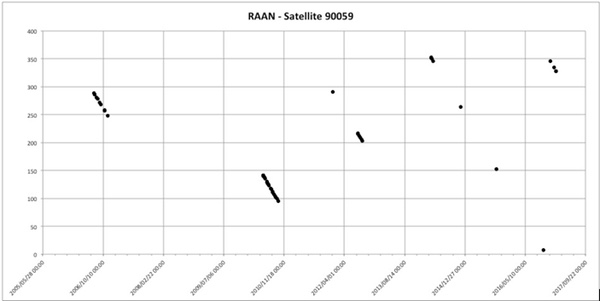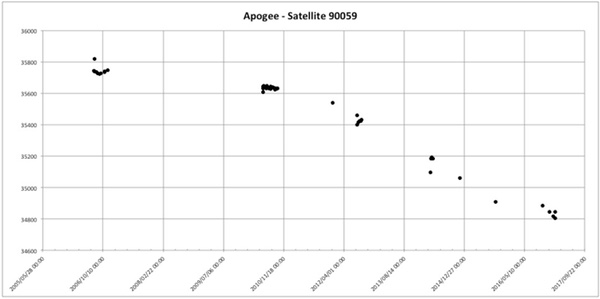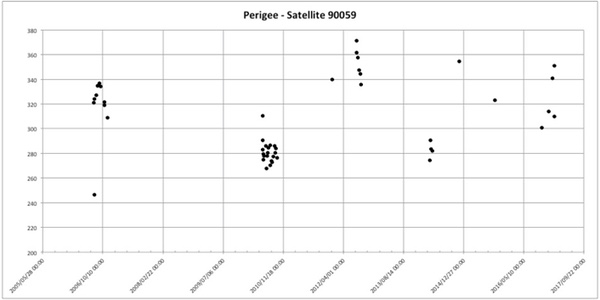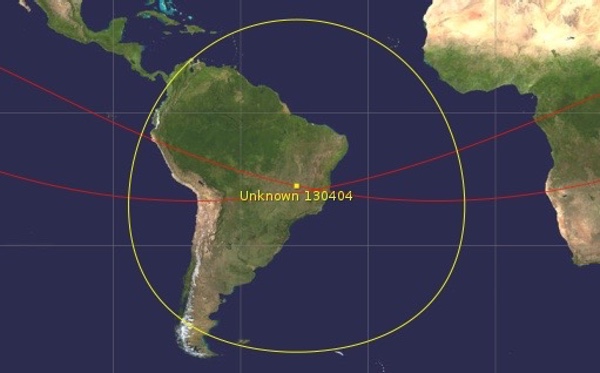Acknowledging some overlooked satellitesby Charles Phillips
|
| When the ones that are in the default catalog reenter, there are multiple alerts to the community, but when a satellite that is not in that satellite catalog reenters, there is no mechanism to alert the people below it. |
Reentries have been interesting to me ever since very early in my career, when I helped predict the impact zone for the Skylab space station, very large pieces of which fell onto Australia in 1979. Let’s look at some satellites, both known and unknown, that will reenter and how people below them are or are not alerted to these events. In the latter case, let’s ask how they could be alerted.
Some of the most interesting satellites are the ones that hit the ground
After a satellite reaches the end of its life, it will ultimately fall back to Earth. Since most of the Earth is not densely populated, most reentries do not pose a threat, and may go unnoticed by most people. There is a mechanism for warning people for many satellites that reenter, as most satellites are in a default “official” catalog and have their orbital parameters updated periodically.
But some are “unknown” satellites. When the ones that are in the default catalog reenter, there are multiple alerts to the community, but when a satellite that is not in that satellite catalog reenters, there is no mechanism to alert the people below it. An earlier story mentioned the reentries of two objects for which pieces were recovered, but for whom there was no alert issued to the population. (See “Time for common sense with the satellite catalog”, The Space Review, April 10, 2017.) People were alarmed by the reentry since they had not been informed that it might happen.
This article identifies and discusses some specific satellites that are “unknown” and have low perigees, since perhaps we should be warning people about them. How do we know about these satellites? How do we know that they are real? Do we need to talk about them?
Satellite catalogs
There are several satellite catalogs available. One is the “default” official one provided by the United States Air Force via the Joint Space Operations Center (JSpOC). Everyone accepts the satellite numbers and “International Designators” that they assign, and it is adequate for many uses.
The Air Force and their support organizations also send alerts out when objects are predicted to reenter, especially if they have a cross sectional area of 10 square meters or more. They are reluctant to discuss this process with people, however, and mainly just refer inquiries on the process to public affairs offices. I have called and talked to people at Vandenberg Air Force Base and have gotten referred to various public affairs offices around the country, where the people say that they don’t know anything about these events and will have to get back to me. I am still waiting. Certainly those people in the government community or who have contracts with the government have far greater access to the information.
One significant problem with this catalog, from the point of view of someone who would like to know what is crashing to Earth, is that the Air Force knows about many objects but will not release their orbital parameters. These are intelligence gathering satellites, their upper stages, and associated debris. When these satellites reenter, there is no warning, as my earlier article described.
| By examining these catalogs you can find some interesting satellites and get their orbital parameters. |
Another catalog that has many satellites that were (apparently) independently discovered is the one provided by the JSC “Vimpel Interstate Corporation” and the Keldysh Institute of Applied Mathematics (IAM), with observations supplied by the International Scientific Optical Network (ISON). Most of these are probably from optical observations. This is made available via a website that has several text files available that the user can copy and process.
There is a lot of information here and interpreting it is not trivial: a user must invest some time into understanding the files. Apparently this catalog is intended to only carry satellites whose period is over 200 minutes, though I have not yet verified that it only has those. They state that their interest is in geosynchronous satellites and satellites that have high eccentricities and high apogees; some of those also will have low perigees. The community that uses telescopes and tracks objects optically tends to follow the higher altitude objects, while the community that tracks with radars tends to follow the lower altitude objects. It takes a considerable amount of power to push a radar signal up hundreds of kilometers above Earth and have it strong enough to produce a detectable signal when it is reflected back to the ground. I will have more to say about this Vimpel catalog when I have finished my code to “parse” and crunch some of their information.
There is a third “catalog” maintained by the observer community (many are astronomers) that is distributed as a text file, there is not a web page like the one for JSpOC that displays orbital information. People around the world observe satellites and send observations in to an email list, then people update orbital parameters with recent observations. Many observers are motivated by tracking intelligence gathering satellites and determining what their mission might be. When observers are confident with a satellite’s identity they will track the satellite using a satellite number that the JSpOC will not confirm. This list incorporates many of the objects from the Russian list but appears to have numerous other objects that were discovered by observers and are unique to this list.
This community is not all easy to deal with, even for people with decades of experience in the space business. However, I have found that some observers are willing to answer questions and look for specific objects if your request is reasonable. This catalog has a number of uncataloged items but they are normally not updated as often as many of those with an “assigned” satellite number.
There are more user-friendly catalogs, which apparently incorporate the JSpOC catalog and the observer catalog. One of the most useful is maintained by Jonathan McDowell, which is free for anyone to use. Chris Peat, in Germany, maintains Heavens Above, a useful catalog that has a good web interface. There are other catalogs that mostly duplicate information from JSpOC, but they are much less useful and sometimes incorporate confusing information.
By examining these catalogs you can find some interesting satellites and get their orbital parameters. The unknown satellites are frequently very interesting: almost certainly they are satellites for whom the orbital parameters are not released by the JSpOC, but the observer community is not confident with assigning them to a particular cataloged satellite.
Of course, there is also the Commercial Space Operations Center (ComSpOC), which has a catalog. As a commercial entity, its information is available to those organizations that pay for it. That seems reasonable since they paid to build and maintain it. Likely this catalog only includes satellites that are at higher altitudes and will not reenter for many years.
Satellites of interest
There are many satellites that have been routinely tracked by ISON and/or the astronomer community (so we know that they are really there) but are not identified as a cataloged object. Since they are not in the JSpOC or ISON catalogs, they also might be from launches where the objects released were not well communicated to the observer community. They could possibly even include large pieces like structural components and engines that were separated with little notice. Wherever they came from, since they are routinely tracked we can know that they are large.
Some of these have low points in their orbits—perigees—that are low enough to cause concern. For instance, the ISS orbits at about 400 kilometers and has to routinely raise its orbit. The ISS often deploys small, normally not dense, cubesats, and they will reenter in about three or four months. Any object whose perigee is significantly lower than about 300 kilometers should be watched. Many satellites who have a low perigee but a much higher apogee can have the perigee increase and decrease over time, due to lunar and solar perturbations. Nonetheless, when a satellite goes down to a perigee of 300 kilometers or less, it should be monitored.
| From looking at these objects, we know for certain that there are some objects in space that will eventually reenter that will not be included in the normal alert process. |
Normally, satellites are considered to have entered the atmosphere when they do down to about 80 kilometers, although larger satellites that are traveling faster (because they have larger orbits) will build up a “bow wave” of air even above 100 kilometers. Final orbits on cubesats normally have a perigee of about 160 kilometers. And, of course, the Earth’s atmosphere expands on the sunlit side, so if perigee was in sunlight there would be some additional drag encountered.
There are three satellites that I have been watching whose perigees go down to about 300 kilometers or below. The most interesting is ISON 320000, also given satellite number 90113. It has a perigee of 254 kilometers and an apogee of approximately 16,800 kilometers. With an inclination of 25.665 degrees it was certainly launched from Cape Canaveral in Florida, and it could impact in many equatorial regions. It has been tracked this year and we can be confident that it is still in orbit.
Another one is ISON 060624, known as 90059. It has a low perigee of 310 kilometers but has an apogee of about 35,000 kilometers, giving it a high eccentricity of about 0.72. According to Ted Molczan, this object has a perigee that goes up and down but shows a long-term decrease in apogee. Looking at historical orbital parameters, it has been tracked sporadically since at least 2006.
I looked at the historical TLEs and first wanted to make sure that they were really from the same object; if so, some parameters should follow regular trends. So I looked at the right ascension of the ascending node (RAAN), if these TLEs were from the same object the RAAN should show consistent trends. And certainly it does, as the figure below illustrates.
 RAAN Changes Since 2006 |
This object has several big gaps where it was not observed, but the consistency in RAAN gives me good confidence that we have one object. The RAAN shows how the orbit steadily precesses to the west, as we would expect (see Fundamentals Of Astrodynamics by Ronald Bate, Donald Mueller, and Jerry White, Dover Publications 1971, p. 156), and when it reaches zero it begins again at 360 degrees.
Looking at the apogee for this object, there is definitely a trend as well.
 Plot of Apogee for 90059 |
Here the apogee shows some variability, likely due to some TLEs being created with more observations than others. But the trend is very apparent; with a higher apogee, this object only experiences atmospheric drag near perigee.
However if we look at perigee the story is not anywhere near so clear. A chart of the perigee over time is much more chaotic.
 Perigee Does Not Show Clear Trends |
We tend to want to find patterns in data like this but the only thing we can have some confidence in saying is that the perigee varies from about 270 to 360 kilometers. If some of these orbits did not match the trend in RAAN and in apogee we might even discard them. The object is at least 150 kilometers above the altitude at which we would think that it would be reentering.
ISON 130404, or 99208, has a perigee of 311 kilometers and a high apogee of 13,000 kilometers. It will be interesting to follow this object and see how the orbit behaves, but it is also not about to reenter. Objects like this, when approaching or receding from apogee, are affected by lunar and solar forces, and this can cause the perigees to rise and fall. Still, every time the object goes down to below 350 kilometers it will slow down due to friction with the air, taking more off of apogee in the short term.
Another interesting object has perigee well below 300 kilometers: 90085, also called Unknown 091017, has a perigee of 224 kilometers. It has a higher eccentricity of 0.65, so it is out of the tenuous atmosphere at apogee. It also probably is an object launched from Cape Canaveral since it has an inclination of 25.14 degrees. It has not been tracked since the middle of 2016, but these objects don’t attract the attention of the objects where we suspect that we know what they are.
The observer catalog currently has 19 objects with these low perigees, including these four; the lowest perigee of the 19 objects is 208 kilometers and two have a perigee of about 216 km kilometers For these objects there is no mechanism in place to warn people that they will reenter—though when they reenter people on the reentry track may be alarmed by the sight, at the very least!
From looking at these objects, we know for certain that there are some objects in space that will eventually reenter that will not be included in the normal alert process. Some may have been tracked routinely but some will not have.
Acknowledgement
The author would like to thank two people for helping with this analysis. Brian Chambers is a colleague and a recent graduate of the University of Houston, Clear Lake. He is a Marine combat veteran who deployed to Iraq once and Afghanistan once. He is also far better at writing C++ code than I am! Jason Post is a PhD candidate in Geosciences at Texas Tech University and is very good at analyzing and visually representing data. He has served his community as a volunteer firefighter and swiftwater rescue technician. Also, fish around the world fear him.
